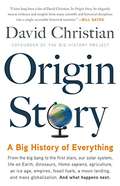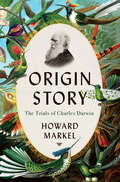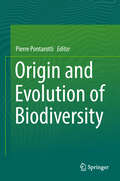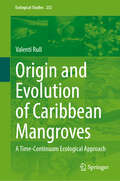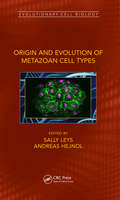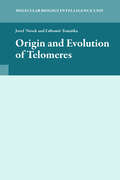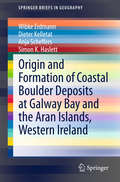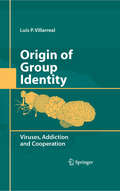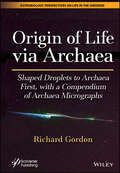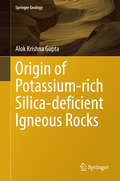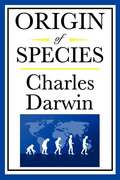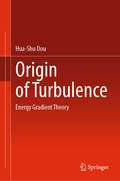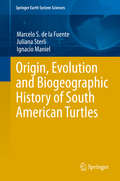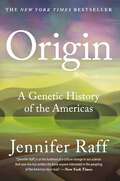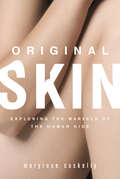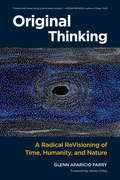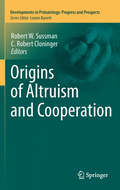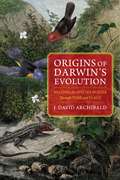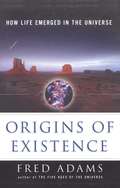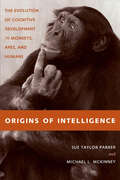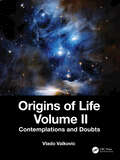- Table View
- List View
Origin Story: A Big History of Everything
by David Christian"I have long been a fan of David Christian. In Origin Story, he elegantly weaves evidence and insights from many scientific and historical disciplines into a single, accessible historical narrative." --Bill GatesA captivating history of the universe -- from before the dawn of time through the far reaches of the distant future.Most historians study the smallest slivers of time, emphasizing specific dates, individuals, and documents. But what would it look like to study the whole of history, from the big bang through the present day -- and even into the remote future? How would looking at the full span of time change the way we perceive the universe, the earth, and our very existence?These were the questions David Christian set out to answer when he created the field of "Big History," the most exciting new approach to understanding where we have been, where we are, and where we are going. In Origin Story, Christian takes readers on a wild ride through the entire 13.8 billion years we've come to know as "history." By focusing on defining events (thresholds), major trends, and profound questions about our origins, Christian exposes the hidden threads that tie everything together -- from the creation of the planet to the advent of agriculture, nuclear war, and beyond.With stunning insights into the origin of the universe, the beginning of life, the emergence of humans, and what the future might bring, Origin Story boldly reframes our place in the cosmos.
Origin Story: The Trials of Charles Darwin
by Howard MarkelA lively account of how Darwin’s work on natural selection transformed science and society, and an investigation into the mysterious illness that plagued its author. By early morning of June 30, 1860, a large crowd began to congregate in front of Oxford University’s brand-new Museum of Natural History. The occasion was the annual meeting of the British Association for the Advancement of Science, and the subject of discussion was Charles Darwin’s new treatise: fact or fiction? Darwin, a simultaneously reclusive and intellectually audacious squire from Kent, claimed to have solved “that mystery of mysteries,” introducing a logical explanation of the origin of species—how they adapted, even transmogrified, through natural selection. At stake, on that summer’s day of spirited debate, was the very foundation of modern biology, not to mention the future of the church. Without fear of exaggeration, Darwin’s thesis would forever change our understanding of the life sciences and the natural world. And yet the author himself was nowhere to be found in the debate hall—instead, he was miles away, seeking respite from a spate of illnesses that had plagued him for much of his adult life. In Origin Story, medical historian Howard Markel recounts the two-year period (1858 to 1860) of Darwin’s writing of On the Origin of Species through its spectacular success and controversy. Simultaneously, Markel delves into the mysterious health symptoms Darwin developed, combing the literature to emerge with a cogent diagnosis of a case that has long fascinated medical historians. The result is a colorful portrait of the man, his friends and enemies, and his seminal work, which resonates to this day.
Origin and Evolution of Biodiversity
by Pierre PontarottiThe book includes 19 selected contributions presented at the 21st Evolutionary Biology Meeting, which took place in Marseille in September 2017. The chapters are grouped into the following five categories: · Genome/Phenotype Evolution · Self/Nonself Evolution · Origin of Biodiversity · Origin of Life · Concepts The annual Evolutionary Biology Meetings in Marseille serve to gather leading evolutionary biologists and other scientists using evolutionary biology concepts, e.g. for medical research. The aim of these meetings is to promote the exchange of ideas to encourage interdisciplinary collaborations. Offering an up-to-date overview of recent findings in the field of evolutionary biology, this book is in invaluable source of information for scientists, teachers and advanced students.
Origin and Evolution of Caribbean Mangroves: A Time-Continuum Ecological Approach (Ecological Studies #252)
by Valentí RullThis book provides a comprehensive, detailed, and coherent spatio-temporal account of Caribbean mangrove evolution from its evolutionary origins to the present that is not available for any mangrove region in the world. Mangroves are intertidal wetland forests that play a crucial role in the maintenance of terrestrial and marine biodiversity, and in the functioning of global biogeochemical cycles (especially the carbon cycle). These ecosystems dominate the tropical/subtropical coasts of all continents and are among the most threatened ecosystems in the world. This book combines all temporal scales, from the geological to the ecological, to provide an integrated picture of mangrove history and the natural and anthropogenic drivers of ecological and evolutionary change. This may be useful not only for understanding the current ecological status of these emblematic ecosystems, but also for informing their conservation in the face of ongoing global change.
Origin and Evolution of Metazoan Cell Types (Evolutionary Cell Biology)
by Sally Leys and Andreas HejnolThe evolution of animal diversity is strongly affected by the origin of novel cell and tissue types and their interactions with each other. Understanding the evolution of cell types will shed light on the evolution of novel structures, and in turn highlight how animals diversified. Several cell types may also have been lost as animals simplified – for example did sponges have nerves and lose them? This book reveals the interplay between gains and losses and provides readers with a better grasp of the evolutionary history of cell types. In addition, the book illustrates how new cell types allow a better understanding permitting the discrimination between convergence and homology.
Origin and Evolution of Telomeres
by Jozef Nosek Lubomir TomaskaLinear chromosomes represent an evolutionary innovation associated with the origin of eukaryotic cells. This book describes how linear chromosomes and primordial pathways for maintaining their terminal structures, telomeres, emerged in early eukaryotes.Telomeres, derived from the Greek meaning terminal part, were first described by Hermann Muller i
Origin and Formation of Coastal Boulder Deposits at Galway Bay and the Aran Islands, Western Ireland
by Wibke Erdmann Dieter Kelletat Anja Scheffers Simon K. HaslettThis book presents geomorphological and sedimentological aspects of Holocene boulder ridges along the coastline of western Ireland (the Aran Islands and Galway Bay). Given these boulders' size, extent and altitude, they are among the most spectacular deposits moved by marine forces worldwide and have challenged researchers to solve their enigmatic history. In particular, the question of how their features were formed (by storm waves or by tsunamis) is a matter of heated debate. The documentation is based on the authors' own field research, including observations on the boulder transport capacity of six extremely strong winter storms in the 2013/14 season. Discussing the arguments published to date and using more than 130 images for clarity, the book addresses the character, setting and extraordinary size of these boulders moved on land, comparing them with the situation along other exposed coastlines of the world.
Origin of Group Identity
by Luis P. VillarrealThe molecular evolution of viruses is fascinating and quite controversial, relevant to the evolution of living organisms, a determinant in pathogenesis by viruses, and amenable to detailed study in various laboratories around the globe. Evolution is the product of variation and selection. Genetic recombination is a major source of variation for evolutionary selection. Full understanding of virus evolution requires knowledge of the inventory of existing viruses, their distribution in biological space and time and their interactions with other viruses and living organisms. The basic focus of this volume will be to trace the evolution (or accumulation) of biological identity systems from molecules to microbes, through animals to primate and human social structure. Overall, the volume will be organized so that it will trace the evolution of group identification systems from simple unicellular life forms, through the 'tree of life' all the way to complex hominid social structures. Such an evolutionary tracing has not been previously published, thus the book will develop and present a unique organization of information. The focus of this book will also be to understand the mechanisms that allow group (social) identification and communication systems to function. Sensory identification systems, especially receptors, will be emphasized. In unicellular and early multicellular organisms, addiction modules (toxins and antitoxins, often from genetic parasites) are most commonly used as biological group identification systems. Later in evolution, odor receptors, in particular, provide a clear evolutionary trail that can be followed from microbes to humans. Photo and visual receptors are also considered along with the neurological systems that process receptor information. Visual and audio based social imprinting will also be presented. In addition, the book will seek to understand the underlying evolutionary forces that drive the creation of group identification systems. In particular, 'addiction' based molecular strategies will be examined. A unique element of this book will be to evaluate the role of genetic parasites in the origination of such addiction modules. The recent explosion of genomic databases and information will be called on heavily as evidence for this part of the book.
Origin of Life via Archaea: Shaped Droplets to Archaea First, with a Compendium of Archaea Micrographs (Astrobiology Perspectives on Life in the Universe)
by Richard GordonThis book surveys the models for the origin of life and presents a new model starting with shaped droplets and ending with life as polygonal Archaea; it collects the most published micrographs of Archaea (discovered only in 1977), which support this conclusion, and thus provides the first visual survey of Archaea. Origin of Life via Archaea’s purpose is to add a new hypothesis on what are called “shaped droplets”, as the starting point, for flat, polygonal Archaea, supporting the Vesicles First hypothesis. The book contains over 6000 distinct references and micrographs of 440 extant species of Archaea, 41% of which exhibit polygonal phenotypes. It surveys the intellectual battleground of the many ideas of the origin of life on earth, chemical equilibrium, autocatalysis, and biotic polymers. This book contains 17 chapters, some coauthored, on a wide range of topics on the origin of life, including Archaea’s origin, patterns, and species. It shows how various aspects of the origin of life may have occurred at chemical equilibrium, not requiring an energy source, contrary to the general assumption. For the reader’s value, its compendium of Archaea micrographs might also serve many other interesting questions about Archaea. One chapter presents a theory for the shape of flat, polygonal Archaea in terms of the energetics at the surface, edges and corners of the S-layer. Another shows how membrane peptides may have originated. The book also includes a large table of most extant Archaea, that is searchable in the electronic version. It ends with a chapter on problems needing further research. Audience This book will be used by astrobiologists, origin of life biologists, physicists of small systems, geologists, biochemists, theoretical and vesicle chemists.
Origin of Potassium-rich Silica-deficient Igneous Rocks (Springer Geology)
by Alok Krishna GuptaThe book summarizes the occurrence, geochemistry, mineralogy, petrology and phase-equilibria studies in air and under high pressures related to the most intriguing group of potassium-rich mafic and ultramafic rocks, often including host of exotic mineral assemblages including feldspathoids. Mantle-derived K-rich melts had intrigued most of the founders of Geology and many of the later experts in the field of Igneous Petrology, because they are sometimes associated with carbonatites and even diamond. They tend to contain anomalous concentration of many such elements as K, Rb, Sr, U, F, P, etc., along with Ni, Co and Cr indicating a mixture of crust and mantle materials. Although these rocks occur rarely in ancient geologic time, they have been erupting mostly in modern geological history (less than last 120 Ma or so). Are the old age data real or the result of a sampling problem? Modern observations leave no doubt that sediments must be subducted on a large scale. There is now evidence that the upper mantle (and perhaps even the lower mantle) is not homogeneous but rather like a fruit cake, and that there are thermal anomalies in the mantle resulting from deep mantle plumes or subduction. Is this related to release of these unusual rocks clearing the mantle of left over subduction materials? This volume, written for those interested in the geochemistry of K-rich melts from the deep Earth, reviews the present state of knowledge of these unique igneous rocks. The author is an expert in the field of Igneous Petrology and the book will serve as a valuable reference book for researchers and academicians in the discipline.
Origin of Species
by Charles DarwinThe Origin of Species is the landmark book that, for better or worse, puts science and religion at odds. Very few people have read this book and come away not believing in evolution. The detail of research is even by today's standards stunning; and the writing is still eminently readable. Second only to the Bible in its scope of influence, this book is a pertinent today as when it was first written.
Origin of Temporal (t > 0) Universe: Connecting with Relativity, Entropy, Communication and Quantum Mechanics
by Francis T.S. YuThe essence of temporal universe creation is that any analytical solution has to comply with the boundary condition of our universe; dimensionality and causality constraints. The essence of this book is to show that everything has a price within our temporal (t > 0) universe; energy and time. In mathematics, every postulation needs proof; there exists a solution before searching for the solution. Yet science does not have seem to have a criterion as mathematics does; to prove first that a postulated science exists within our temporal universe. Without such a criterion, fictitious science emerges, as already have been happening in every day’s event. In this book, the author has shown there exists a criterion for a postulated science whether or not it is existed within our universe. The author started this book from Einstein’s relativity to the creation of our temporal universe. He has shown that every subspace within our universe is created by energy and time, in which subspace and time are coexisted. The important aspect is that every science has to satisfy the boundary condition of our universe; causality and dimensionality. Following up with temporal universe, the author has shown a profound relationship with the second law of thermodynamics. He examines the relationship between entropy with science as well as communication with quantum limited subspace throughout the book. The author discusses the paradox of Schrödinger’s Cat (which has been debated by Einstein, Bohr, Schrödinger and many others since 1935) that triggered his discovering that Schrödinger’s quantum mechanics is a timeless machine, in which he has disproved the fundamental principle of superposition within our universe. Since quantum mechanics is a virtual mathematics, he has shown that a temporal quantum machine can, in principle, be built on the top of a temporal platform. This book is intended for cosmologists, particle physicists, astrophysicists, quantum physicists, computer scientists, engineers, professors and students as a reference and research-oriented book.
Origin of Turbulence: Energy Gradient Theory
by Hua-Shu DouThis book presents the new discovery of the origin of turbulence from Navier–Stokes equations. The fully developed turbulence is found to be composed of singularities of flow field. The mechanisms of flow stability and turbulent transition are described using the energy gradient theory, which states all the flow instability and breakdown resulted from the gradient of the total mechanical energy normal to the flow direction. This approach is universal for flow instability in Newtonian flow and non-Newtonian flow. The theory has been used to solve several problems, such as plane and pipe Poiseuille flows, plane Couette flow, Taylor–Couette flow, flows in straight coaxial annulus, flows in curved pipes and ducts, thermal convection flow, viscoelastic flow, and magnet fluid flow, etc. The theory is in agreement with results from numerical simulations and experiments. The analytical method used in this book is novel and is different from the traditional approaches. This book includes the fundamental basics of flow stability and turbulent transition, the essentials of the energy gradient theory, and the applications of the theory to several practical problems. This book is suitable for researchers and graduate students.
Origin(s) of Design in Nature
by Richard Gordon Liz Swan Joseph SeckbachOrigin(s) of Design in Nature is a collection of over 40 articles from prominent researchers in the life, physical, and social sciences, medicine, and the philosophy of science that all address the philosophical and scientific question of how design emerged in the natural world. The volume offers a large variety of perspectives on the design debate including progressive accounts from artificial life, embryology, complexity, cosmology, theology and the philosophy of biology. This book is volume 23 of the series, Cellular Origin, Life in Extreme Habitats and Astrobiology. www.springer.com/series/5775
Origin, Evolution and Biogeographic History of South American Turtles
by Marcelo S. Fuente Juliana Sterli Ignacio ManielThe extended continental South American turtle record (Norian to Lujanian) allows us to follow the evolution of this reptile clade from its origins. Several significant stem turtle taxa such as: Palaeochersis talampayensis and Condorchelys antiqua provide information on the first steps of turtle evolution. Others such as: Chubutemys copelloi or Patagoniaemys gasparinae provide clues to the origin of the bizarre horned tortoises of the clade Meiolaniidae. The panpleurodiran species such as Notoemys laticentralis or Notoemys zapatocaensis shed light on the origin of modern pleurodiran turtles. This book explores aquatic and terrestrial cryptodiran turtles, South Gondwana pleurodiran turtles, North Gondwana pleurodiran turtles; Meiolaniforms and early differentiation of Mesozoic turtles.
Origin: A Genetic History of the Americas
by Jennifer RaffAN INSTANT NEW YORK TIMES BESTSELLER!From celebrated anthropologist Jennifer Raff comes the untold story—and fascinating mystery—of how humans migrated to the Americas.ORIGIN is the story of who the first peoples in the Americas were, how and why they made the crossing, how they dispersed south, and how they lived based on a new and powerful kind of evidence: their complete genomes. ORIGIN provides an overview of these new histories throughout North and South America, and a glimpse into how the tools of genetics reveal details about human history and evolution.20,000 years ago, people crossed a great land bridge from Siberia into Western Alaska and then dispersed southward into what is now called the Americas. Until we venture out to other worlds, this remains the last time our species has populated an entirely new place, and this event has been a subject of deep fascination and controversy. No written records—and scant archaeological evidence—exist to tell us what happened or how it took place. Many different models have been proposed to explain how the Americas were peopled and what happened in the thousands of years that followed. A study of both past and present, ORIGIN explores how genetics is currently being used to construct narratives that profoundly impact Indigenous peoples of the Americas. It serves as a primer for anyone interested in how genetics has become entangled with identity in the way that society addresses the question "Who is indigenous?"
Original Skin: Exploring the Marvels of the Human Hide
by Maryrose Cuskelly"Like the air we breathe, we take our skin for granted . . . Yet it is remarkable; it mitigates and ameliorates the sometimes harsh world we dwell in, and is at the interface of so much of what we encounter. It is our border, the edge of ourselves, the point where we meet our universe."Original Skin is at times a scientific study, remarking on the biological magic behind the human body's largest organ. At others it becomes an anthropological survey, dissecting separate societies' attitudes towards bare bodies, and the motives behind cultural rituals such as tattoos. However, Original Skin is, above all, a celebration of the human body; its tone one of absolute awe for the simultaneously protective and fragile membrane that divides us all from the world that surrounds us. Maryrose Cuskelly's book-in its examinations of everything from tickling to Botox to books bound in human derma-is a delightful meditation on skin.
Original Thinking
by James O'Dea Glenn Aparicio ParryIn Original Thinking, Glenn Aparicio Parry delves into the evolution of Western thought to recover the living roots of wisdom that can correct the imbalances in our modern worldview. Inspired by groundbreaking dialogues that the author organized between Native American elders and leading-edge Western scientists to explore the underlying principles of the cosmos, this book offers a radical revisioning of how we think. Asking questions such as, Is it possible to come up with an original thought?, What does it mean to be human?, and How has our thinking created our world today?, Parry challenges us to consider many of our most basic assumptions. To think originally--as in thinking new thoughts that have never been thought or said before--is according to Parry, largely an illusion. So, too, is the idea of linear human progress. Most of us have traveled far from our ancestral lands, and in so doing, lost connection with place, the origin of our consciousness.Original Thinking offers a radical revisioning of how we think and what it means to be human. It invites us to reintegrate our hearts with our heads and to expand our self-imposed narrowing of consciousness. In doing so we reconnect with the living, original source--nature and her interconnected elements and cycles--and embrace the communion of old and new, rational and intuitive, and masculine and feminine. Ultimately, Parry shows us how to create the tapestry of truly original thinking and to restore thought as a blessing, as a whole and complete transmission from Spirit.ContentsPART ONE (ORIGIN): Is it possible to come up with an original thought?Chapter 1. Original Thought, Time, and the Unfolding of ConsciousnessChapter 2. Looking Backward to Go ForwardChapter 3. Wheels Within Wheels Chapter 4. It's About Time PART TWO (DEPARTURE): What does it mean to be human? Chapter 5. Purpose, Potential, and Responsibility of Being Human Chapter 6. Rational Thought and Human Identity Chapter 7. Re-thinking Language Chapter 8. Beyond Rationality Chapter 9. A Tale of Two Directions PART THREE (RETURN): How has our thinking created the world today,and what is emerging? Chapter 10. The Essence of Thought Chapter 11. To Make Thought Whole Again Chapter 12. To Think Without Separation Chapter 13. Re-Thinking the "Dismal Science" Chapter 14. Toward An Original Economics PART FOUR (RENEWAL): Can education promote the renewal of original thinking? Chapter 15. Education as Renewal Chapter 16. Childhood and EducationChapter 17. Higher Education Chapter 18. A New (and Ancient) Vision Chapter 19. A Vision for Higher Education
Origins of Altruism and Cooperation
by Robert W. Sussman C. Robert CloningerThis book is about the evolution and nature of cooperation and altruism in social-living animals, focusing especially on non-human primates and on humans. Although cooperation and altruism are often thought of as ways to attenuate competition and aggression within groups, or are related to the action of "selfish genes", there is increasing evidence that these behaviors are the result of biological mechanisms that have developed through natural selection in group-living species. This evidence leads to the conclusion that cooperative and altruistic behavior are not just by-products of competition but are rather the glue that underlies the ability for primates and humans to live in groups. The anthropological, primatological, paleontological, behavioral, neurobiological, and psychological evidence provided in this book gives a more optimistic view of human nature than the more popular, conventional view of humans being naturally and basically aggressive and warlike. Although competition and aggression are recognized as an important part of the non-human primate and human behavioral repertoire, the evidence from these fields indicates that cooperation and altruism may represent the more typical, "normal", and healthy behavioral pattern. The book is intended both for the general reader and also for students at a variety of levels (graduate and undergraduate): it aims to provide a compact, accessible, and up-to-date account of the current scholarly advances and debates in this field of study, and it is designed to be used in teaching and in discussion groups. The book derived from a conference sponsored by N.S.F., the Wenner-Gren Foundation for Anthropological Research, the Washington University Committee for Ethics and Human Values, and the Anthropedia Foundation for the study of well-being.
Origins of Darwin's Evolution: Solving the Species Puzzle Through Time and Place
by J. David ArchibaldHistorical biogeography—the study of the history of species through both time and place—first convinced Charles Darwin of evolution. This field was so important to Darwin’s initial theories and line of thinking that he said as much in the very first paragraph of On the Origin of Species (1859) and later in his autobiography. His methods included collecting mammalian fossils in South America clearly related to living forms, tracing the geographical distributions of living species across South America, and sampling peculiar fauna of the geologically young Galápagos Archipelago that showed evident affinities to South American forms. Over the years, Darwin collected other evidence in support of evolution, but his historical biogeographical arguments remained paramount, so much so that he devotes three full chapters to this topic in On the Origin of Species.Discussions of Darwin’s landmark book too often give scant attention to this wealth of evidence, and we still do not fully appreciate its significance in Darwin’s thinking. In Origins of Darwin’s Evolution, J. David Archibald explores this lapse, showing how Darwin first came to the conclusion that, instead of various centers of creation, species had evolved in different regions throughout the world. He also shows that Darwin’s other early passion—geology—proved a more elusive corroboration of evolution. On the Origin of Species has only one chapter dedicated to the rock and fossil record, as it then appeared too incomplete for Darwin’s evidentiary standards. Carefully retracing Darwin’s gathering of evidence and the evolution of his thinking, Origins of Darwin’s Evolution achieves a new understanding of how Darwin crafted his transformative theory.
Origins of Existence
by Ian Schoenherr Fred C. AdamsIn Origins of Existence astrophysicist Fred Adams takes a radically different approach from the long tradition of biologists and spiritual leaders who have tried to explain how the universe supports the development of life. He argues that life followed naturally from the laws of physics -- which were established as the universe burst into existence at the big bang. Those elegant laws drove the formation of galaxies, stars, and planets -- including some like our Earth. That chain of creation produced all the tiny chemical structures and vast celestial landscapes required for life. Ultimately, physical laws and the complexity they generate define the kind of biospheres that are possible -- from an Amazon rain forest to a frigid ocean beneath an ice sheet on a Jovian moon. Adams suggests that life was not merely some lucky break, but rather a natural outcome of the ascending ladder of complexity supported by our universe. Since our galaxy seems to harbor millions of planets with the same basic elements of habitability as Earth, the emergence of life is probably not a rare event. If life emerges deep inside planets and moons, as new research suggests happened on our planet, the number of viable habitats is truly enormous. Seven chronological chapters take the reader from the laws of physics and birth of the universe to the origins of life on Earth -- showing how energy flowed, exploded, and was repeatedly harnessed in replicating structures and organisms. In his groundbreaking first book, Fred Adams established the five eras of the universe with a focus on its long-term future. It is perhaps not surprising that he now turns his attention to the mystery of our astronomical origins. Here is a stunning new perspective, a book of genesis for our time, revealing how the laws of physics created galaxies, stars, planets, and even life in the universe.
Origins of Existence: How Life Emerged in the Universe
by Fred AdamsIn his groundbreaking first book, "Five Ages of the Universe, " Adams established the five eras of the universe from birth to demise. Now, he gives readers a stunning new perspective on how the laws of physics created a nonrandom universe and life itself.
Origins of Intelligence: The Evolution of Cognitive Development in Monkeys, Apes, and Humans
by Sue Taylor Parker Michael L. McKinneySelected by Choice Magazine as an Outstanding Academic TitleSince Darwin's time, comparative psychologists have searched for a good way to compare cognition in humans and nonhuman primates. In Origins of Intelligence, Sue Parker and Michael McKinney offer such a framework and make a strong case for using human development theory (both Piagetian and neo-Piagetian) to study the evolution of intelligence across primate species. Their approach is comprehensive, covering a broad range of social, symbolic, physical, and logical domains, which fall under the all-encompassing and much-debated term intelligence.A widely held theory among developmental psychologists and social and biological anthropologists is that cognitive evolution in humans has occurred through juvenilization—the gradual accentuation and lengthening of childhood in the evolutionary process. In this work, however, Parker and McKinney argue instead that new stages were added at the end of cognitive development in our hominid ancestors, coining the term adultification by terminal extension to explain this process.Drawing evidence from scores of studies on monkeys, great apes, and human children, this book provides unique insights into ontogenetic constraints that have interacted with selective forces to shape the evolution of cognitive development in our lineage.
Origins of Intelligence: The Evolution of Cognitive Development in Monkeys, Apes, and Humans
by Sue Taylor Parker Michael L. McKinneyA look at the origins of cognitive abilities in primate species.Since Darwin’s time, comparative psychologists have searched for a good way to compare cognition in humans and nonhuman primates. In Origins of Intelligence, Sue Parker and Michael McKinney offer such a framework and make a strong case for using human development theory (both Piagetian and neo-Piagetian) to study the evolution of intelligence across primate species. Their approach is comprehensive, covering a broad range of social, symbolic, physical, and logical domains, which fall under the all-encompassing and much-debated term intelligence.A widely held theory among developmental psychologists and social and biological anthropologists is that cognitive evolution in humans has occurred through juvenilization—the gradual accentuation and lengthening of childhood in the evolutionary process. In this work, however, Parker and McKinney argue instead that new stages were added at the end of cognitive development in our hominid ancestors, coining the term adultification by terminal extension to explain this process.Drawing evidence from scores of studies on monkeys, great apes, and human children, this book provides unique insights into ontogenetic constraints that have interacted with selective forces to shape the evolution of cognitive development in our lineage.“The authors’ elegant theory and comprehensive empirical synthesis of how the development of human intelligence and brain evolved opens up cascading heuristic avenues for creatively answering one of the great questions in the human history of ideas.” —Jonas Langer, Human Development“A handy source of information on comparative cognitive abilities related to life history and brain variables.” —James Anderson, Journal of the Royal Anthropological Institute
Origins of Life Volume II: Contemplations and Doubts
by Vladivoj ValkovicIn Origins of Life Volume II, life and its origin are inspected from traditional and unexpected points of view. The book takes an interdisciplinary approach, discussing astrobiology; chemical evolution; and how the Universe accommodates life, molecular biology, and philosophy. It is an open-minded approach, fully referenced throughout, and each chapter includes a further reading section for anyone wishing to learn more about that perspective on the origins of life.First, everything started, with the Big Bang, from nothing. It appears now that everything was aiming toward our existence, some 13.75 × 109 years later, being capable of understanding it all. We did it using powerful tools: science, philosophy, and religion. Although we appreciate the contributions made by philosophy and religion, our contemplations and doubts are based on the plentiful scientific evidence provided.The reader will be guided from make-up of the "life stage" (Universe), tools and materials needed for the living matter to be formed in the small part of the Universe, which one could call Human Neighborhood, or the Local Universe. It contains galaxies, galaxy clusters, and voids, and the Milky Way and its satellites influencing each other during this time span.The book is easy to read, accompanied by numerous references; it could be of use to the expert in the field as well as for curious minds with a scientific, philosophical, or religious background.
